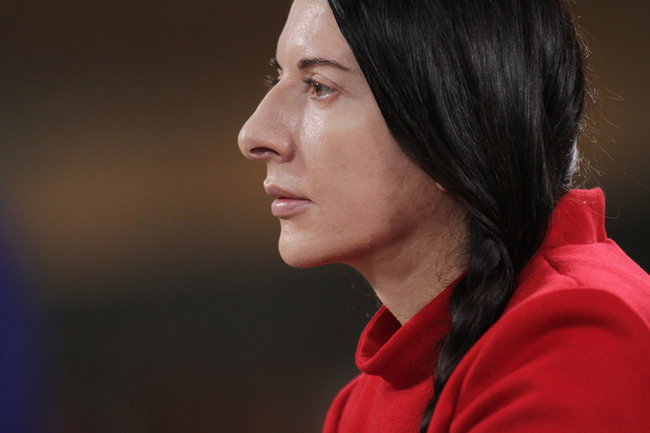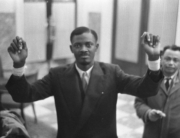
Marina Abramovic, as seen in her performance piece, "The Artist Is Present" (David Smoler/ Music Box Films)
This celebratory and fascinating documentary tops off what have been two very good years for the Yugoslavian-born artist Martina Abramovic. Her 2010 blockbuster retrospective at New York’s Museum of Modern Art, “The Artist Is Present,” drew over 750,000 visitors, and there are not many artists who hit their stride in their sixties, though she has grabbed attention (and raised eyebrows) as a performance artist for 40 years. The exhibition captured the sort of media buzz that most museums pray for, a lot of the fuss having to do with the nude performers re-creating many of her historical pieces. The main attraction was also called “The Artist Is Present”—and how! Abramovic remained silently seated without a bathroom or meal break for seven-and-a-half hours, six days a week, for three months straight—a nearly inhuman feat of patience and physical endurance.
Abramovic calls herself an artist, rather than an actor, yet her work shares basic performing skills. The main goal for her and a voluntary participant, who sits about five feet across from her before a roomful of spectators, is to shed one’s ego and become vulnerable. It’s also one of the desired outcomes for acting guru Sanford Meisner’s (in)famous repetition exercise: two actors, also directly facing each other, repeat a stated observation back and forth. The point is to shift one’s focus onto the scene partner, allowing the reactions to become spontaneous, as opposed to behaving based on preconceived ideas. In other words, learning to be, uh, present. (Admittedly, this is a simplification.)
“The Artist Is Present” also brings back memories of another acting trick: the mirror exercise (like Harpo Marx and Lucille Ball’s famous bit from I Love Lucy). Again, an actor takes physical cues from another, mirroring his/her movements. (It’s a good cure for a wandering attention span on stage). It’s seen in many of the montages, with both Abramovic and her partner leaning towards each other or repeating the same hand-to-heart gesture.
Just before each interaction, Abramovic lowers her head, closes her eyes, exhales, and then lifts her head up to meet the gaze of a stranger for the next intimate encounter—it’s showtime. Even her former collaborator and ex-lover Ulay confides to the camera that “she’s never not performing.” Like an opera diva, she admits she lives for the audience, but Abramovic has a point—she’s not creating an illusion. In acting, the performer uses fake blood. She, on the other hand, really did cut and mutilate herself for a performance piece in the mid-’70’s. Her body is still her canvas.
The film captures well the results of the main event, one cathartic success after another. Smiles beam and tears gush from more than a few participants, but it only touches upon the process itself. To record the patience that the project requires from both participants would have radically altered a film that will soon air on doc friendly HBO, the home of full-frontal nudity. This sort of overwhelming concentration takes time. Yet if you can wait for hours in line to be seated across from her, then what’s a couple of minutes of face time?
By focusing on the exhibit’s centerpiece, the film overlooks an opportunity to examine whether her performance pieces, many of which she created with Ulay in the 1970s and ’80s, are reproducible in an austere museum space. My impression is that yes, her confrontational works remain unsettling, and the public’s reaction to them are integral to her success. We’re part of the show. Forget the nude models or the provocative video installations; it was more my fellow museumgoers that I was observing. How do you react when you walk through an entryway between a naked man and woman standing less than a foot a part (“Imponderabilia”), and where do you put your hands? (And no, I didn’t have the patience to wait in line for “The Artist Is Present,” nor to watch surrounded by the crowds.)
What distinguishes director Matthew Akers’ film is not just what it personally reveals about Abramovic, but in what it revels in—“I love fashion,” she blurts to the camera. After years of making no money and living in a van, she makes no apology for now adorning designer clothes. She may physically suffer in her work, but she doesn’t bring it home—her beautiful sun-filled Soho loft. Though she may still avow that artists should avoid being the subjects of idolatry, she obviously doesn’t mind the material side effects.






astounding documentary…the artist is present was a revelation of understanding the significance of our innate need to be visible to one another…deeply moving, whether you wanted to be moved or not.